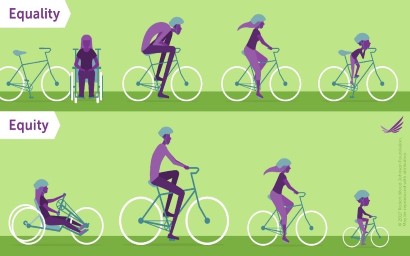
We hear about it all the time, and we know it’s important, but what is “social equity” and what does it mean for your park agency? At NRPA, we believe equity is inherent in the philosophy of public parks and recreation because everyone — regardless of skin color, sexual orientation, ability or ethnicity — deserves a great park. However, historically, not every community has seen the same investment in their parks and open spaces.
What is Equity?
Equity and equality are often used interchangeably, but they mean different things. Equality is when everyone receives the equal amount of investment. While that sounds fair, it assumes that all people start from the same place, which isn’t true. Equity is about ensuring everyone receives the appropriate investment for where they are. Consider the bike image:

Under equality, everyone receives the same bike, which does not meet the needs of every person. With equity, recognizing each person starts at a different place, each cyclist receives the appropriate bike. The same principle is true of park usage and access. Some communities need more investment because they have historically been underserved.
History of Inequity in Parks and Recreation
The history of park usage and access has not been an equitable one. For example, communities of color faced segregation through “separate but equal” and Jim Crow policies, where white communities would see more investment in parks and infrastructure than African American communities. The effects of those policies and underinvestment continue to be seen today. A study done by University of Missouri Professor KangJae Lee studied African American use of parks today.
Professor Lee says, “Many of the adults I spoke with were raised by parents who experienced discriminatory Jim Crow laws, which prevented or discouraged African Americans from visiting public parks… Park attendance in America is culturally embedded, meaning children who are raised going to parks will grow up to take their children. Many African Americans do not go to parks because their parents and grandparents could not take their children.”
History of discrimination applies to other marginalized minority groups, such as low-income, immigrant and new American, physical and cognitive disability, and LGBTQ+ communities, leaving them to not feel welcome in public parks and spaces. Cities across the country are realizing the impact of underinvestment in these areas and are acting to advance equity in their cities.
Advancing Equity in Your City
As public servants, we have a responsibility to ensure that we are adopting inclusive practices into all areas of parks and recreation, including planning and programming. At NRPA, we are working to help agencies bring equity to their communities. Our Parks for Inclusion and 10-Minute Walk initiatives are ground in equity and provide best practices from your peers on how to achieve equitable park access and quality.
PolicyLink, a national leader in advancing economic and social equity, describes equity as “just and fair inclusion into a society in which all can participate, prosper, and reach their full potential. Unlocking the promise of the nation by unleashing the promise in us all.”
When we help those in our cities that have felt the disproportional burden of underinvestment, we make our communities and cities stronger, better places for everyone.
Jared Mummert is a Program Specialist for NRPA.

